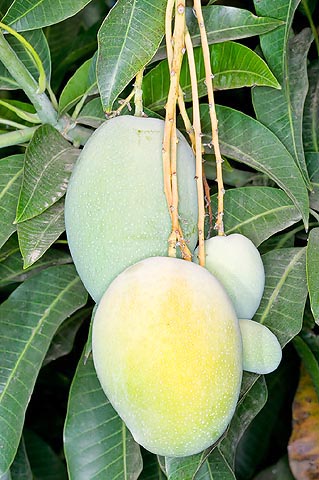Family : Anacardiaceae

Text © Pietro Puccio

English translation by Mario Beltramini

Rootstock of mango in humid climates © G. Mazza
The name of the genus comes from the combination of one of the local names of the fruit, “manga”, with the Latin verb “fero” = I carry; the Latin name of the species, “laurina” = similar to the bay laurel (Laurus nobilis), refers to the appearance of the leaf.
Common names: “mangga kopyor”, “mangga pari” (Indonesian); “mango ayer” (English); “mango de agua” (Spanish).
Evergreen tree, tall up to about 25 m, with a diameter of the trunk which can reach the 1,5 m in the most aged specimen, brown bark and branches bent upwards and forming a thick and shady crown; the sap coming out from possible incisions in the bark, with an intense smell of turpentine, may cause irritation to the skin, in particular in the most sensitive subjects.
It shows oblong-lanceolate leaves, 15-25 cm long and 4-6 cm broad, which are tough and glossy green on the upper page, dark green on the inferior side.
The inflorescences are terminal, panicle, erect, 25-40 cm long, with flowers with a diameter of about 10 mm.
The fruits are ovoid, or kidney-shaped drupes, long 5-6 cm and 4 cm thick, of a pale yellow colour or greenish yellow, liquescent pulp when ripe, of an intense yellow colour and with a sweet taste, slightly acidulous, with a slight taste of turpentine. The seeds are oval, often polyembryonic.
By now little cultivated plant for the fruits, which are usually utilized unripe as ingredient in fruit salads, as it has been replaced by the varieties of mango (Mangifera indica); the unripe fruits are matter of entertainment for the kids who make a small hole in the peel and, squeezing the fruit, thanks to the liquescent pulp, can drink its juice.
Due to its adaptability to the cultivation in plain areas with humid climate, where the mango is not suitable, and due to its remarkable resistance to some fungal diseases, such as the anthracnose (Colletotrichum gloeosporioides), it is utilized as rootstock, especially in Malaysia, and in the researches for the mango genetic improvement.
Synonyms: Mangifera longipes Griff. (1854); Mangifera parih Miq. (1859); Mangifera sumatrana Miq. (1859).
→ To appreciate the biodiversity within the ANACARDIACEAE family please click here.
